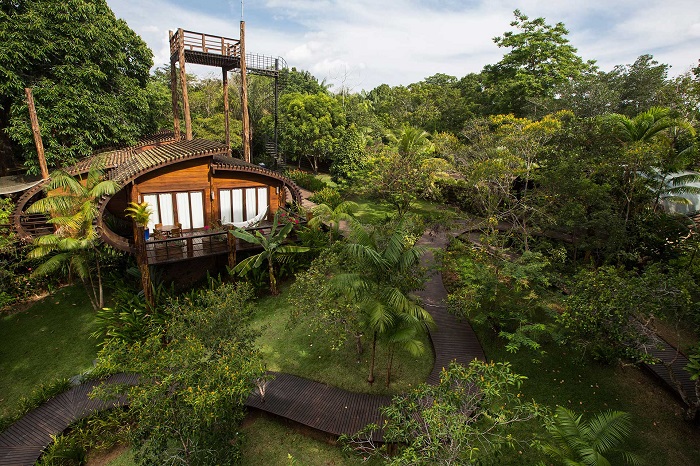ISABEL RUBIO ARROYO | Tungsteno
The adobe houses of the Andes region of Peru, the wooden homes of the Black Forest in Germany and the bamboo dwellings in the Brazilian Amazon are all examples of vernacular architecture. This is architecture that uses the traditional building techniques and materials of a region and is passed down from generation to generation. We look at how contemporary architecture draws on the styles and techniques of the past.
Shrines in Japan and a mosque in Mali
Among the most inspiring examples of vernacular architecture, the RMJM architecture studio highlights the Shinto shrines of Japan, built with cypress timber and bamboo frameworks without nails or glue; the wooden stave churches of Norway; and the Great Mosque of Djenné in Mali. In the last example, Africans used sand and earth-based mortar to make sun-baked bricks, which they then covered with mud to achieve a rounded, sculpted finish. The smooth surfaces are perforated with palm-wood support beams, which serve as ready-made scaffolding for the annual repairs to the building in which the local community takes part.
The Great Mosque of Djenné is designed to take advantage of natural light and ventilation. Credit: Wikimedia Commons.
In the 21st century, this type of architecture is still a reality in rural areas and indigenous communities in some parts of the world. In recent years, there has also been a growing interest in vernacular architecture in the Western world. This is partly due to increased awareness of sustainability and the importance of cultural identity.
Back to building with the land
"Building again with the land, with what the region gives us, is one of the most important ways for the rural areas of our countries to maintain self-management of their own well-being," says Ana María Gutiérrez, director and co-founder of the Organizmo project. She explains that some deserts, such as the Guajira in northern Colombia, are ideal for building with earth because it produces the ideal thickness that provides coolness. "But now, in these areas, communities live in houses that are cement ovens, where they can't even remain. That's where the dialogue of promoting, accepting and motivating local soils and resources for building comes in," she explains.
There are also researchers who study the resilient constructions of the past. "It is a privilege for us Chileans to have a building as old as the church of San Francisco in such a seismically active country," Carolina Vergara, director of the San Francisco Museum, told the Sinc news agency. The church, located in the Chilean capital and built from blocks of stone and brick, is 405 years old this year and has survived around 15 major earthquakes.
The church of San Francisco in Chile has been standing for more than 400 years. Credit: Drone Project Chile
Several researchers have tried to unlock the secrets of this church. In addition to the Mudejar coffered ceiling, which improves the building’s seismic performance by binding together the roof and the 1.7m-wide stone walls of the church, these thick walls are supported by cobblestones embedded in loose sand and soil. This allows the building to "skate" on its foundations during a seismic event.
Embracing ancient techniques
There are currently several projects that have worked to incorporate ancient techniques. One such example is the headquarters of the Instituto Socioambiental, a Brazilian non-governmental organisation dedicated to the protection of the environment and the rights of indigenous peoples. Its designers, from the Brasil Arquitetura studio, were inspired by Amazonian vernacular architecture: "We used indigenous people's skills with wood and vines to build the roof and also the 1.50m-wide peripheral structure that "wraps" the core of the building, protecting it from the weather." They note that the structure relates to its surroundings through the use of wood and straw.
Another example is the luxurious Mirante do Gavião Amazon Lodge in Brazil's Anavilhanas National Park, which was created with the local climate and materials in mind. It was designed as an inverted boat, employing the techniques used for years by the riverside community to construct wooden boats. It is built on stilts that create connected wooden decks, allowing ventilation underneath the structure and reducing interior temperatures.
The Mirante do Gavião Amazon Lodge is built of wood and shaped like an upside-down boat. Credit: Blumar DMC
Among the traditional materials used today are adobe, bamboo and stone. They are attractive because they do not generate waste—one of the objectives pursued by many builders. As the architecture firm RMJM states, "it is important for modern architects to consider the materials and techniques of vernacular architecture, as it is often linked to environmental sustainability for its intuitive use of local materials and social sustainability."
· — —
Tungsteno is a journalism laboratory to scan the essence of innovation.
